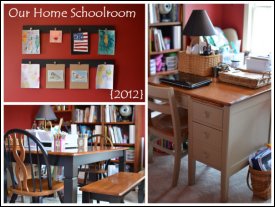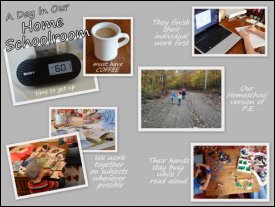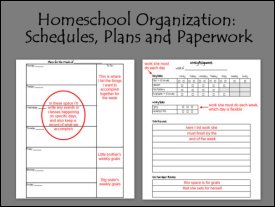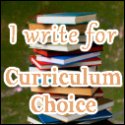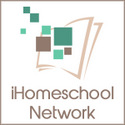2014-2015 Curriculum and Plans
I’m almost ready for the new school year to begin. We continue relaxed learning during the summer months, but come September we’ll resume our full-time schedule. (We never start before Labor Day–summer is short in Maine!). Here are my written-in-pencil plans for my nearly-nine-year-old boy and my just-turned-twelve-year-old girl.
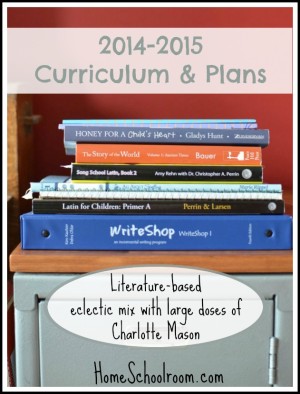
Before I start, let me say that I have made great progress in not planning too much, and it has improved the atmosphere of our homeschool. I also find myself aligning even more closely to Charlotte Mason’s ideas, which are a simplification of the subjects I tend to complicate. I have read some inspiring posts on planning and scheduling recently, which I’ll discuss more when I post our daily schedule. In short: I now indicate how long we will work on a certain subject in my plans.
Independent Work
In this case “independent” means the work each child is assigned that is not combined with their sibling. Some of it may be truly independent, some of it may be one-on-one work with me.
12-year-old Daughter (7th grade)
She will receive a weekly list of her independent work, laying down habits necessary for high school learning.
Math
- Teaching Textbooks: 30-45 minutes (usually one complete lesson) daily.
- Life of Fred: The story concept appeals to my daughter and I like approaching math concepts in another format for her. It was on the schedule last year but not done very often, we will try again this year.
Language Arts
- Writing: Daily for 30 minutes. This will take the form of a WriteShop lesson that we do together or her independent writing projects.
- Spelling: No formal spelling. We address misspelled words in her writing and that is enough for her.
- Grammar: She has requested more grammar. I’ll add it to her schedule to read one of our grammar books once a week (like Nitty-Gritty Grammar), and I’m looking for an editing practice book.
- Literature: Read 30 minutes daily from a literature list I’ve prepared using Ambleside Online, Honey for a Child’s Heart and Read for the Heart.
- Latin: Continue working on Latin for Children Primer A for 15 minutes daily. At the beginning of each chapter we watch the video together.
Music
- Continue with private piano lessons and practice 30 minutes daily.
Almost-9-year-old son (3rd Grade)
He will have a daily list to work from for his independent work, as he is not ready for a weekly list yet.
Math
- Teaching Textbooks: Daily for 20 minutes. I will continue to sit with him for the lessons, possibly transitioning to him working alone soon. He usually only finishes part of a lesson each day either the lecture or the problems. Charlotte Mason reminder: keep lessons short at this age.
- Math facts: Practices these through games and apps, try XtraMath this year.
Language Arts
- Reading: Daily for 30 minutes. He will read for 15 minutes, then I will read. He read to me daily last year, this year I am adding the time limit and reading to him. These are both intended to make this as pleasant a time as possible.
- Another 20 minute language arts session daily: we’ll work on All About Spelling (or a game like sight word bingo or ideas from Beechick’s Three R’s) and end with copywork. Two notes: All About Spelling is a program I purchased for my daughter but found it unnecessary for my naturally good speller. Now I see the tactile nature of the tiles are a great fit for my son. Also I stay close by for copywork to assure he does his best work.
- Literature: I also prepared a literature list for him. He will listen to audiobooks 20 minutes each day, and can play with Legos or play dough or something of the sort while he listens.
- Journal: We’ll continue keeping a journal to write back and forth to each other. This is usually done later in the day or at bedtime.
- Latin: We will listen to the songs from both levels of Song School Latin together before lunch. I will do some of the activities orally, but he will not do the written work.
Music
- Continue with private guitar lessons and practice 15 minutes daily.
Together Work
I combine subjects when possible. What wonderful relationships with each other and with learning it builds for our family! Our combined learning will be broken into three blocks: Tea Time, Learning Lunch, and a Together Block.
Tea Time
At 11:00 daily we will come together for a treat for bodies and minds. This was a new (and very popular) addition to the schedule last year, this year I’m expanding on it.
A few things will happen daily at tea time:
- Bible Reading
- Memory Work: we’ll work on memorizing scriptures, hymns, and poetry
- Poetry: we’ll read poems each day, sometimes choosing from an anthology, other times focusing on one poet for a while. I will also ask my daughter to choose poems some days and read them aloud to us.
These things will be on a loop schedule:
- Composer studies: We’ll take composers one at a time. We’ll read about their lives and play their music daily during tea time. When it comes up in the loop we’ll do a SQUILT (affiliate link) lesson for that composer.
- Artist studies: Similar to composer studies: learn about the artist’s life and art and do Charlotte Mason style picture study of one of the artist’s pieces when it comes up in the loop. I hope to collect nice art prints (old calendars are a good source) so I can have the piece on display.
- Sketch Tuesday: Barb posts a weekly theme at Harmony Fine Arts, then prepares a slideshow of all the sketches people send in. This is an art highlight for us.
- Poetry: When poetry comes around in the loop we’ll dig a little deeper into one poet and learn about his life, or learn about a particular style of poetry.
Learning Lunch
I like to make good use of my captive audience at lunchtime. These things will happen daily:
- Listen to Song School Latin chants as we prepare lunch. These are helpful even for my daughter, who had no Latin base before beginning Primer A.
- Watch Student News–keep a map handy to locate where stories are happening.
- Bedtime Math: a fun way to get my kids thinking about math outside their lessons. The part I like best is the focus on real-world problem solving and that they have to figure out what operation to use to solve the problem.
And we’ll finish out lunch with audiobooks or videos (documentaries, Horrible Histories, Beakman, Bill Nye, Science Friday, etc.).
Together Block
This is roughly an hour we’ll spend together after lunch and can be spent in a variety of ways.
History
We will continue to use SOTW as a framework (this year volume 2) but dig deeper using books from All Through The Ages. The kids will narrate. This can be a simple retelling (orally for my son, written for my daughter) or sometimes be done in more creative ways. Crafts and hands-on activities are to be done sparingly. (Remember, I’m a reformed over-planner!)
Science
We still will not use a year-long formal science curriculum, but science will be part of our school in many ways.
- Nature Study is a big piece of our current science education, mostly interest-led. We will continue keeping nature journals and aim for weekly entries except in the depths of winter. The subjects my kids choose are usually quite different. If my son has a snake for a while or my daughter brings in flowers to draw, they both learn from each other’s interests.
- Videos we watch during learning lunch bring up many other topics.
- I plan in-depth science units between history units. Last year it was the weather and the human body. This year I’m aiming for chemistry, but I’m not sure which resource I’ll use yet and it won’t happen until after Christmas, so I have time!
- Read alouds: Even science is literature-based. I read nonfiction books and scientist biographies aloud.
- Hands-on: We provide as many tools for hands-on exploration as possible. Microscopes and other real science tools, Snap Circuits, Lego Robotics. My son’s interests often lead to reverse engineering broken things: vacuum cleaners, blow dryers, music boxes…
- Outside classes: We will attend classes available in our area. I won’t be sure of these until the school year is up and running. A children’s museum and new planetarium at a university are both hoping to offer homeschool classes. As is often the case, these will be dependent on enough people signing up to attend.
Literature
Oh, how I love to read aloud with my children! I plan to continue the habit until they leave home. We will continue our relaxed book club with one other family, meeting whenever we’re done reading to discuss the books. Our children all keep Reader’s Response journals.
We’ve enjoyed three Shakespeare plays so far. I read them a retelling, then we see the play (live or recorded). We’ll hopefully do more of the same this year. Perhaps we’ll memorize a little Shakespeare?
Brain Breaks: I have to include this in our curriculum list because I’m so glad to have found this resource! Our Brain Breaks cards get very regular use in our homeschool.
Extracurriculars
We try not to run around too much, but we do have to get out and socialize, right?
- music lessons
- Scouts
- Homeschool Rollerskate once a month
- Possibly gym time at a local recreation department
- Field Trips: I love them! We try to join in on those organized by others, and have arranged a few of our own. The usual ideas like museums, historical sites, and performances (plays, orchestras) are great, and we also try places like wildlife sanctuaries and businesses…any place we can think of that would be interesting and willing.
Phew! I know that’s a long list, so I appreciate you reading all the way through.
Are you ready for the school year?
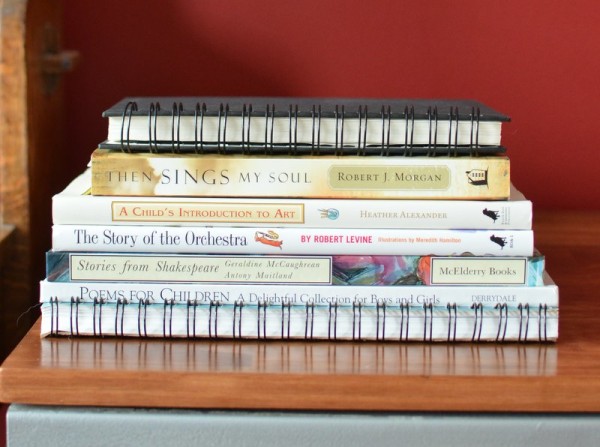
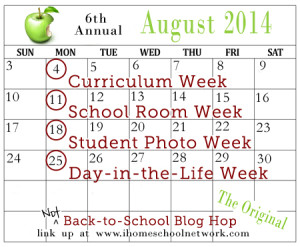
 Hi, I'm Heidi and I homeschool my two sweet kids. I want them to know that learning is an exciting lifelong adventure! We love great books, unit studies, notebooking, lapbooking, and hands-on learning.
Hi, I'm Heidi and I homeschool my two sweet kids. I want them to know that learning is an exciting lifelong adventure! We love great books, unit studies, notebooking, lapbooking, and hands-on learning.